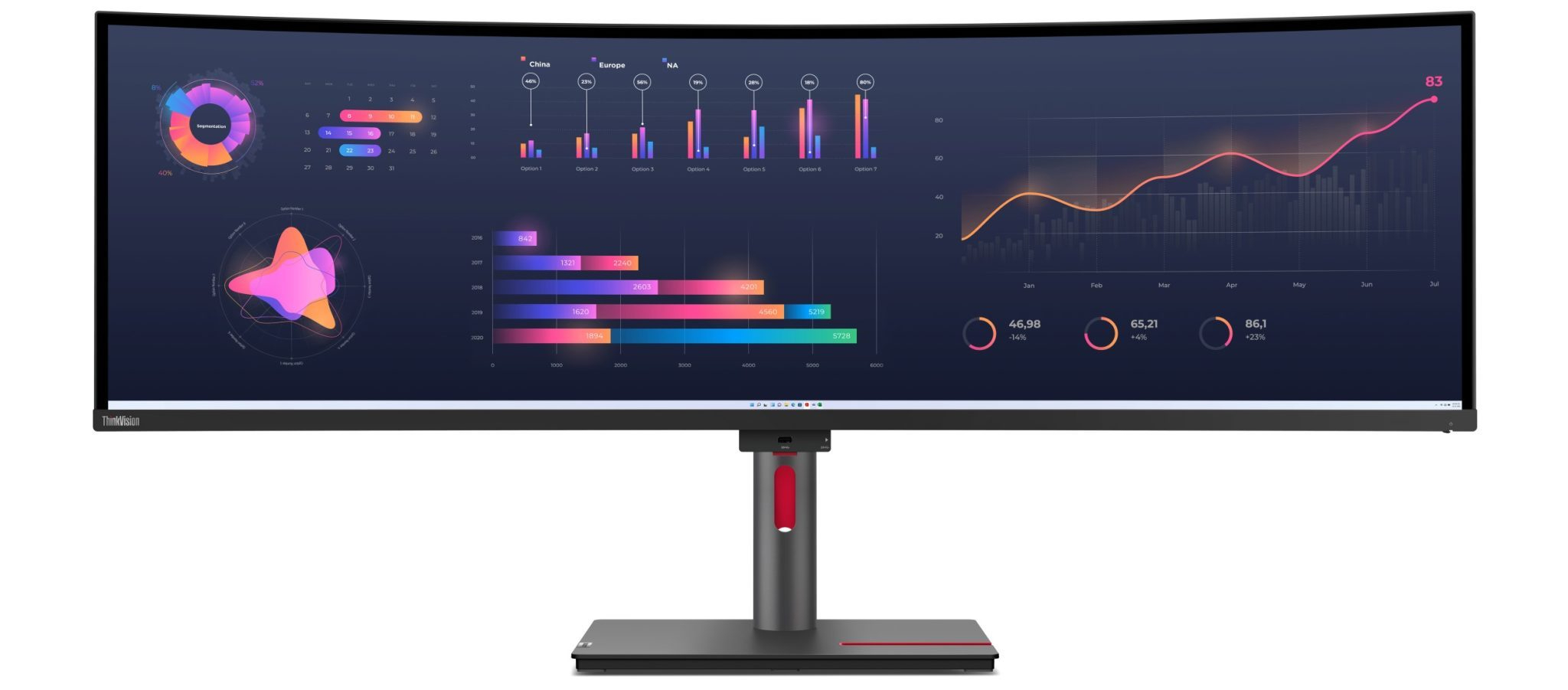Lenovo Announces New ThinkVision Monitors Including 49-inch Dual QHD Monster
Lenovo announced updates to its ThinkPad X1 laptops and convertibles today, presumably featuring the mobile versions of Intel's 13th-generation Raptor Lake processors. The new laptops will ship in April, but that isn't the only thing Lenovo announced: The company also pulled the wraps off a couple of ThinkVision monitors -- including a massive 49-inch ultrawide unit that will dominate just about any desk.
Expect to learn more about all of these products in early January at CES 2023.
Starting things off is the ThinkVision P32p-30, a 31.5-inch 4K monitor. The monitor sports an IPS panel with a 1000:1 contrast ratio, 6ms response time (4ms in Extreme Mode), 60Hz refresh rate, and a maximum brightness of 350 nits. The ThinkVision P32p-30 covers 100 percent of the sRGB and 95 percent of the DCI-P3 color spaces.
There aren't any surprises here, as the monitor features a three-sided "borderless design" and EyeSafe Certified 2.0 support. Like most ThinkVision monitors, connectivity options to enhance workers' productivity are plentiful, including support for the ThinkVision VoIP Modular Stack. It also incorporates two HDMI 2.0, one DisplayPort 1.4, two Thunderbolt 4, two USB 3.2 (Gen 1) Type-A, and an RJ45 port. Finally, the monitor is adjustable for tilt, swivel and height.

But the real showstopper is the ThinkVision P49w-30, which measures 49 inches diagonally and rocks a 5120 x 1440 resolution. While most IPS panels feature a contrast ratio ranging from 1000:1 to around 1300:1, the ThinkVision P49w-30 ups that figure to 2000:1.
This monitor has productivity on the mind, so you won't find ultra-low response times or high refresh rates here. Instead, you get the same 6ms/4ms response time and 60 Hz refresh rate of the smaller ThinkVision P32p-30. Maximum brightness is also identical at 350 nits, while DCI-P3 coverage inches up slightly to 98 percent (sRGB color space figures haven't been announced).
The ThinkVision P49w-30 ups the port count, bringing two HDMI 2.1, one DisplayPort 1.4, two Thunderbolt 4, four USB 3.2 (Gen 1) Type-A, one USB 3.2 (Gen 1) Type-C (with 15-watt charging support), and an RJ45 port. While the ThinkVision P32p-30 doesn't include speakers, the larger ThinkVision P49w-30 throws in dual 5-watt speakers.
According to Lenovo, the ThinkVision P32p-30 launches in April 2023, priced at $999, while the ThinkVision P49w-30 will bow in June 2023 for $1,699.
Get Tom's Hardware's best news and in-depth reviews, straight to your inbox.

Brandon Hill is a senior editor at Tom's Hardware. He has written about PC and Mac tech since the late 1990s with bylines at AnandTech, DailyTech, and Hot Hardware. When he is not consuming copious amounts of tech news, he can be found enjoying the NC mountains or the beach with his wife and two sons.
-
TechieTwo Is this 49" monitor designed so that you can see it on your office desk while working from home? ;)Reply -
Angry.dad Reply
Yeah I don't understand the use case. This is mediocre for gaming (refresh rate, hdr coverage, etc) , and similarly for work (obnoxiously wide, low ppi) .TechieTwo said:Is this 49" monitor designed so that you can see it on your office desk while working from home? ;) -
halfcharlie One would have to be quite clueless to not understand the use case after many years of such monitors being available and inferior multi-monitor setups existing for decades before that. Both the wideness and perfectly high but not too high PPI are indispensable for productivity, as well as gaming immersion and performance, take it from someone who has done both from home on this size monitor for over 2 years. That being said what I don't understand is the appeal of this particular monitor, sure nice contrast from the IPS panel, but I bought a better 49" super-ultrawide than this over two years ago for less money which has a 120hz refresh rate and other features required for gaming which this does not three years later once it's released.... I'm just waiting for true OLED super-ultrawides, and a few more inches wouldn't hurt either, being only as tall as a 27" is slightly smaller than I desire, the height of a 32" would be ideal.Reply -
DavidLejdar There certainly are use cases. Such as when at work using 3 apps mostly, with a dual-screen setup, it wouldn't make sense to give each app one third of the total screen area, as one app would be split onto two screens.Reply
As for differences between such ultrawide screens, this one can e.g. daisy chain further screens, it can charge laptop directly from the docking station (accessible from the front), it can run input from two PCs side-by-side, and with the KVM-switch also letting one work on other PCs with the same keyboard and mouse. From what I know, not every such screen comes with such features. And sometimes it can be just about availability. E.g. when U.S. will soon be producing screens of the 23rd century, but not allow export of them to anyone, there still is a demand for screens elsewhere. -
HundredthIdiot Reply
OLEDs aren't great for text clarity. I tried using an LG C2 OLED for productivity work and returned to my IPS panels.halfcharlie said:I'm just waiting for true OLED super-ultrawides, and a few more inches wouldn't hurt either, being only as tall as a 27" is slightly smaller than I desire, the height of a 32" would be ideal.
To me, the most appealing on-paper productivity and light gaming monitor currently on sale is the LG 40WP95C. Incredible resolution, perfect height, useful multi input modes and VRR. Only 72Hz though.
That said, nothing I've used beats my 2017 iMac for text clarity. Even when running as a secondary display under Linux, it blows away the LG 32" 4K monitor I run as my primary. It's just a little too small for my liking.